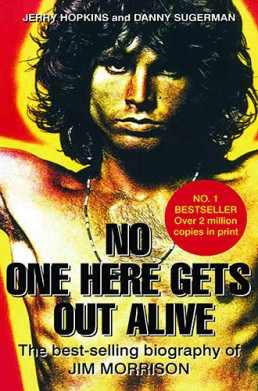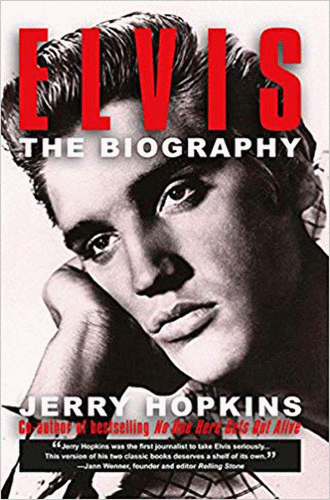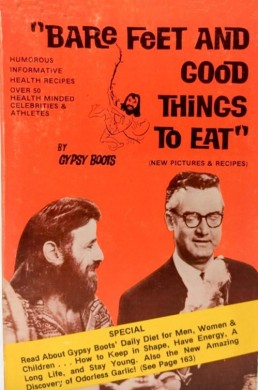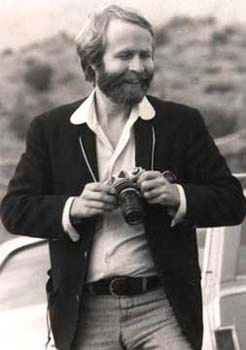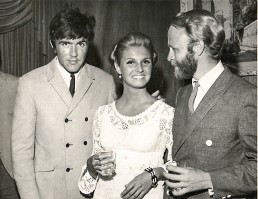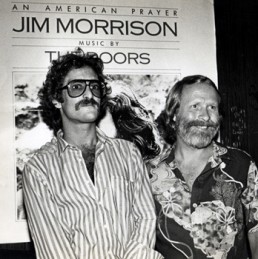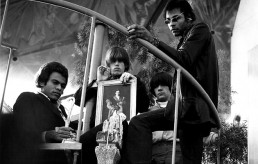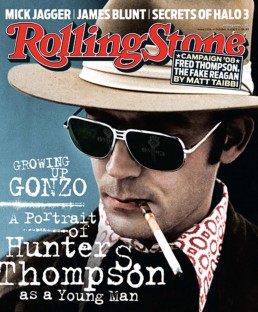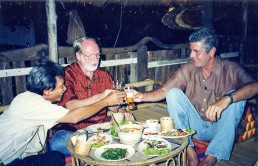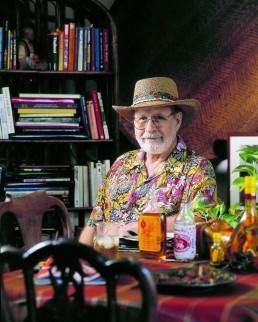The cult author of No One Here Gets Out Alive, Jerry Hopkins reflects on the Doors frontman’s mysterious death, on Frank Zappa’s 'musical bicycle', on Hunter S Thompson’s alarming wardrobe, and on getting busted thanks to 'the most dangerous man in America'.
THE BRAZEN HEDONISM and exotic strangeness of Bangkok agree with writer Jerry Hopkins. Cult author of No One Here Gets Out Alive, the definitive portrait of 1960s psychedelic rock band the Doors’ frontman Jim Morrison, Hopkins has been described as “the dean of pop biographers”. He laughingly refers to himself as a free-spirited “bottom feeder” and a fortunate “Jerry Gump”.
“I’ve been in the right place at the right time often in my life, just like Forrest Gump,” says the 77-year-old American, who also penned the first ever bio of Elvis Presley, as well as accounts of Jimi Hendrix, David Bowie and Yoko Ono. As Los Angeles correspondent for Rolling Stone magazine in the late 1960s, Hopkins experienced the highs and lows of flower power in full bloom.
“Being in LA in the 1960s was the right place if you were going to write about music and the youth revolution, or whatever you want to call it, and that’s what I did, and that’s where I was, and I had a helluva good time.”
FOUR TIMES MARRIED and with two grown-up children in the US, Hopkins has lived in Thailand since 1993, and his Bangkok apartment nestles on a downtown side street. Frangipani blossoms float over garden walls, and scarlet-backed flowerpeckers, white-vented mynas and other tropical birds perch in its knotted banyan trees.
With his thinning grey hair and trimmed beard, thick spectacles, beige slacks and gaudy Hawaiian shirt, the writer has the avuncular air of a retired civil servant.
A short stroll from Hopkins’ restful hideaway, however, lies the Thai capital’s main thoroughfare of sex-tourism, Soi Nana, off Sukhumvit Road, where street stalls ply hardcore porn DVDs and Viagra (about 10 bucks for four of grandpa’s little helpers), as well as chromed knuckledusters, ninja throwing stars and equally dangerous-looking sex toys.
“Being a bottom feeder has a long literary tradition,” says Hopkins. “There’s a whiff of danger about Bangkok. I hate to romanticise dirt, but we’re talking whores and drugs and the fun things in life. Life’s more fun as a bottom feeder.”
Over almost half a century, Hopkins has delivered three-dozen books covering everything from rock-chick groupies and the history of the condom to spoof astrology and aphrodisiacs. He has, by his own admission, enjoyed an unconventional career by chasing down the outré and the bizarre.
No One Here — the first rock biography to reach number one on the New York Times bestseller list — has never been out of print since 1980, selling in the millions worldwide.
“Morrison was the most interesting of all the rock stars I met because he was the best conversationalist,” Hopkins says, reaching into his refrigerator, the door of which sports Doors and Presley fridge magnets. “Something I always had trouble with at Rolling Stone was that I was interviewing people whose avenue of communication was singing or playing an instrument.
“Why should anyone expect them to have a political opinion worth listening to? Most of them didn’t, but Morrison was interesting on a totally different level.”
HOPKINS POURS TWO glasses of iced tea, changes the battery in his hearing aid and sits to reminisce on sex and drugs and rock’n’roll — on Morrison’s perplexing death in Paris at the age of 27, on iconoclastic writer Hunter S Thompson’s weird dress sense, and on his own penchant for transsexual street hookers.
We begin in the year the Doors signed their first record deal. The soundtrack to that heady 12 months featured the Byrds’ Fifth Dimension, Bob Dylan’s Blonde on Blonde and the Beatles’ Revolver.
“1966 was a great year,” says Hopkins, recalling how he had already “tucked a flower behind my ear” and embraced the countercultural zeitgeist. “I guess ’67 was the ‘Summer of Love’, but ’66 was when all the great records came out.
“Things were getting terrible in Vietnam and civil rights was bubbling away, but we thought we were gonna change the world. We really believed that, and I don’t think any generation since has shared that level of … I would prefer to use the word positivism as opposed to naiveté.”
It was 1966 when Hopkins and a friend opened what was only the third “psychedelic store” or “head shop” in the United States. Los Angeles was “a headquarters” for the prevailing drug culture, he says, so that would be the name of their store.
“Headquarters was the first head shop in Los Angeles. I didn’t even know what a head shop was. I’d been working in TV and I’d grown uncomfortable. My buddy was in the same mental state, so I said let’s quit and open a store. It must have something to do with drugs.”
“We were the community centre for the hippy generation. Kids would hang out in the afternoon so they didn’t have to go home to mom and dad. They could be with these hip guys who openly sold rolling papers”
Jerry Hopkins
The shop was in Westwood, close to the UCLA campus that provided its core customer base. The choice of location owed as much to lechery as utility.
“As my partner put it, ‘I fell in love more times per block than in any other neighbourhood.’ We were the community centre for the hippy generation. Kids would hang out in the afternoon so they didn’t have to go home to mom and dad. They could be with these hip guys who openly sold rolling papers.
“We sold lapel buttons, which were a big thing at the time: Save Water, Shower With A Friend; Even Paranoids Have Real Enemies, and the like. We had Peter Fonda posters, Bob Dylan posters, and a selection of maybe 15 underground newspapers from across the country.
“When the brass band of [minor league hockey team] the Los Angeles Blades changed their uniforms, we got the old ones. We sold them as Sergeant Pepper uniforms. Harrison Ford, an out-of-work actor and carpenter at the time, sold us Fillmore dance posters.”
It wasn’t long, however, before similar stores — taboo-breaking purveyors of roach clips, hash pipes and assorted drug paraphernalia — were sprouting like magic mushrooms from coast to coast, and Hopkins takes “blame” for their proliferation.
“Headquarters had been open for about six months,” he explains with a boyish chuckle, “when I was quoted in Newsweek as saying, ‘We’re gonna gross US$50,000 this year if things continue as they’re going.’ I could just hear dopesters all over the country saying [adopts a clichéd stoner voice], ‘Hey man, let’s open a head shop.’
“My partner’s father couldn’t understand how we could possibly make $50,000 a year when there was nothing in the shop costing more than a dollar. He suspected we were dealing drugs, and I think a bit of that might have been going on. Typewriter cases changed hands in the store. I’m not sure they always contained typewriters.”
BORN IN 1935 in New Jersey, Hopkins’ long and strange trip from Quaker roots to Californian bohemia began significantly earlier than the ’60s. The author claims that two of his ancestors had come to the US on the Mayflower.
“I have that kind of colonial history,” he says. “My early settler antecedents founded my little hometown in 1720. All kinds of stuff there is named Hopkins. My parents were not particularly religious, though — it was a heritage thing to send me to the Quaker school. My father drove the school bus, so I got free tuition.”
Strangely, it was conflict rather than peaceniks that guided “the last kid to be picked for the baseball team” in his unusual career.
“During World War II, I would read the dispatches of [Pulitzer Prize-winning correspondent] Ernie Pyle. He covered Europe and then the Pacific. He died in the Pacific, in fact. I decided that was what I wanted to do when I grew up: travel the world, meet interesting people, write about them and get paid for it. I was aged nine then, and I’ve never wavered.”
After university in Virginia, a graduate degree from Columbia University in New York, two years at a newspaper in New Orleans and a stint in the army in Georgia, Hopkins found himself back in the Big Apple.
“I worked as a writer-producer on a Mike Wallace show, but it never really got traction or an audience, so it got canned,” he says. “Mike went onto much greater things at CBS and I was asked if I wanted to go west to work for Steve Allen, who’d invented The Tonight Show. It was 1962. I was in a marriage that wasn’t working. Hell, she had thrown me out and I was sleeping on a friend’s couch, so I headed for LA.
“Steve needed somebody who could come up with an off-the-wall person, or an act, that Steve could bounce off for comedy effect, five nights a week. So I became his ‘vice president in charge of left-fielders’. I was Steve’s ‘kook-booker’. Some of the people were genuinely strange.”
FINDING CRANKS AND eccentrics to appear on the new The Steve Allen Show proved easier than Hopkins had imagined.
“You find safe little corners. Circus people, for instance — a fire-eater, a wire-walker — took care of 12 scattered evenings. The whole idea was to get people to teach Steve something outlandish. This, of course, was southern California, where all the nuts and flakes wound up. That helped. Even today I think, ‘Wow, I got paid for that?’”
Hopkins searched out zany nonconformists from the proto-hippies, “health weirdos” and other subcultures cautiously edging into mainstream in the early 1960s.
“There was a bunch of people who almost lived in the trees,” says Hopkins. “The most famous was Eden Ahbez, who wrote the song Nature Boy that became a big hit for Nat King Cole. Eden and a bunch of others represented the early fruits-and-nuts bunch. One was a fella who called himself Gypsy Boots.”
Hopkins first met Boots in 1962, while the kook booker was having his hair cut by Jay Sebring, later to become stylist to heavy-hitter celebrities like Warren Beatty and Steve McQueen, as well as to Morrison himself (Sebring would be murdered alongside actress Sharon Tate by members of the Manson Family in 1969).
“Gypsy came in selling health-food sandwiches,” Hopkins says. “Long beard, long hair, fast-talking, a little bit crazy. He became a good friend.”
Boots would become a regular guest on the show, sharing his eco-friendly outlook and once cajoling Allen into milking a goat on camera. “In fact the first book I ever wrote was his life story,” says Hopkins, of Boots’ ghost-written Bare Feet & Good Things to Eat (1965). “I never made any money on it. Never wanted to.”
Another oddball was a pre-fame Frank Zappa, who Hopkins first met in 1963.
“He called and told me he wanted to teach Steve ‘musical bicycle’. I knew it was a put-on, and Steve had always insisted no put-ons, but Frank sounded interesting, so he came along.
“He played the spokes like a harp. He beat on the seat and blew at the handlebars. He would not admit it was a joke. Then, years later [in 1966], suddenly here comes Frank Zappa. He’s got long hair and a funny Zapata moustache and a new album called Freak Out!”
Frank Zappa plays musical bicycle on 'The Steve Allen Show'. Video: DRMUX/YouTube
HAVING BECOME DISILLUSIONED with television, and later with the head shop suffering financially (“The big department stores started taking our business — if you wanted a poster of Peter Fonda, you could get it at the May Company”), Hopkins found himself at a loose end. But another golden opportunity would soon present itself.
“Back then, Rolling Stone was a twice-monthly newspaper, tabloid size. I’d seen a box in one of the early issues — we sold Rolling Stone in the store. They were soliciting for freelance submissions, so I sent in a review of a Doors concert. They printed it and sent me a cheque for US$15. I thought, ‘This is terrific.’”
Soon, Hopkins became San Francisco-based Rolling Stone’s Los Angeles correspondent (he remained on the publication’s masthead for 20 years as a contributing editor), interviewing Morrison several times.
“I wasn’t a close friend of Jim, but more than an acquaintance. I really liked the Doors. I thought they were …” Hopkins sighs, polishing his glasses. “They were worthy of attention as musicians, and I thought Jim’s drunken-asshole antics got in the way of them getting the respect they deserved.
“That first article [about the Doors] was a little critical. I called Jim pretentious. He deliberately threw himself into the audience and I thought that was a little precious, but I really liked their lyrics and I really liked Morrison. We drank in the same bars and he would invite me to poetry readings and screenings and stuff. I went to Mexico for a week with them, and toured with them on the West Coast.”
“It’s true that Jim was a drunken asshole, but that wasn’t all he was. He read more books and was more articulate than anyone else I’ve ever met in the entertainment world … He was a poet”
Hopkins on Jim Morrison
Hopkins gleaned many personal insights into Morrison while covering the Los Angeles music scene, and film director Oliver Stone used Hopkins’ interview notes, as well as No One Here, as backbone to his 1991 biopic The Doors. The movie’s release resulted in the biography bounding back to the top of The New York Times bestseller list, this time to the number-two spot, but the writer is conflicted about Stone’s cinematic portrayal.
“The look of the movie was bang on,” Hopkins says. “It was like being whiplashed into my past. Oliver had everything very accurate visually, which is interesting [considering that] 40 per cent of the screenplay turned out to be total fiction.
“It’s true that Jim was a drunken asshole, but that wasn’t all he was. He read more books and was more articulate than anyone else I’ve ever met in the entertainment world. He had a sense of humour about himself. He didn’t take his stardom seriously. He was a poet. He was a lot of things that Oliver ignored.”
Hopkins has only praise, however, for the movie’s star. “Val Kilmer was brilliant. He had Morrison down. Before shooting, Oliver wanted to fly me to LA — I was living in Hawaii then — to ‘pick my brain’.
“I said there’s nothing more in there. It was 1990, after all. I’d sold [Stone] my interview transcripts, some 200 in total, and he’d bought the book rights, but he flew me to LA to have dinner with him and Val anyway.
“I got there early and there was no reservation for a Mr Stone, so I walk into the bar and there’s Jim Morrison talking on the wall phone. It was Kilmer, of course, already wearing the leathers and the long hair. He looked just like Morrison. My first thought was, ‘I’d forgotten Jim was so tall.’ Kilmer really did a good job, but Oliver sees the 1960s differently from the way it was.”
Hopkins also disagrees with Stone’s painting of Morrison’s girlfriend Pamela Courson as long-suffering casualty of the rocker’s philandering and boozing.
“Jim suffered too,” Hopkins says, laughing aloud. “Pam was a piece of work — absolutely beautiful, but very demanding, very jealous. She was a heroin addict. She played around herself. She was wild. Let’s just say she was Jim’s match.”
IN THE OFFICIAL French police report concerning Morrison’s death, Courson found the singer dead in their Paris apartment’s bathtub on July 3, 1971, apparently of a heart attack. He was quickly buried in the French capital’s Père Lachaise Cemetery. Conspiracy theories regarding the exact circumstances have multiplied ever since.
“I get blamed for this,” says Hopkins. “The Morrison book was written in 1972, 1973, and it wasn’t published for seven years or so. My original plan had been for two different final chapters. One ending would have Jim overdosing on a combination of heroin and alcohol. [In the second version] he faked his death and, like his idol, the French poet Rimbaud, he wandered off to North Africa to gain the freedom that anonymity would give him. He was fed up with being a star.
“I suggested that if the publisher were to print 10,000 copies of the book, 5,000 should have one ending, and 5,000 the other. Distribute them and don’t say anything, which I still think is an interesting concept. [The publisher] said that was too much trouble, and to put the two chapters together, end the book ambiguously, which I did.
“So now, many people say that book created the controversy over whether Morrison is dead or alive, and of how he died, and blah, blah, blah.”
“The risks he took, in terms of the drugs and alcohol, and the quantity … In a way it’s almost a miracle that he made it to 27”
Hopkins
Hopkins insists that the true cause of Morrison’s death had been “very well established long before my book came out”, and the writer is not culpable for crackpot theories.
“America lets go of its heroes very reluctantly,” Hopkins says. “It’s quick to build them up and slap them down, but it doesn’t want them to die, and Morrison did die under mysterious circumstances. He was in the ground before anyone had announced his death, and there was no autopsy. Well, no autopsy was required.
“Jim and I shared an agent, and a publisher and an editor (there were a lot of coincidences between him and me), and the agent told me that once she was having dinner with Jim and beat poet Michael McClure. She told me that Jim had said that he felt like an old man, close to death.
“The risks he took, in terms of the drugs and alcohol, and the quantity … In a way it’s almost a miracle that he made it to 27.”
AT THE TIME of Morrison’s death, Hopkins had just wrapped up the book Elvis: A Biography, which he had undertaken on the personal suggestion of Morrison, who had been fascinated by Presley. With that book on the shelves, the writer rejoined Rolling Stone in 1972. He was soon sent to cover the British music scene from London.
“It was the year after Morrison died, and I went over to Paris to research his death,” Hopkins says. “Everybody I spoke to told me he’d suffered a heroin overdose in the Rock’n’Roll Circus nightclub, and that he had been carried home. Well, what do you when somebody has an overdose?”
Hopkins says a bath of cold water was commonly considered helpful to drug users suffering from a surfeit of heroin.
“And that’s where he died, in a bathtub. But the truth would have caused problems for others present, so they created this lie that he’d had a heart attack. A doctor came and there were no signs of violence or foul play. It was the 4th of July weekend, which was no big deal for Paris but the American embassy was closed. [Morrison] was in the ground in a hurry.”
Hopkins admits, however, that he is troubled to this day by Morrison’s reported use of heroin. “That had not been his drug,” insists Hopkins. “Jim did do a lot of cocaine, but his drug of choice, since long before he died, had been alcohol.
“In my Rolling Stone interview with him in the early summer after the Miami arrest [for indecent exposure onstage] of March ’69, he said that he had switched to alcohol because it was so much easier to obtain [than illegal drugs]. You just walked into a store, put your money on the counter and they gave you a bottle. He didn’t want the hassle any more.”
DRUGS AND ALCOHOL, unsurprisingly, played significant supporting roles in the California hippy scene of the late 1960s and early ’70s, and there was a dark side to the adulation, money and “other perks” that young musicians gained so quickly. Hopkins recalls a psychedelic folk-rock combo that he attempted to manage in the mid ’60s.
“There was this band, man, playing at a club called Bido Lito’s. It was just an alley joint,” he remembers. “I thought Love were just fucking brilliant, and so a friend and I became their managers. We took them into a studio and recorded four or five songs, but we didn’t know what we were doing, and the quality was terrible.”
Love, under new management, went on to release a series of albums, including the critically acclaimed Forever Changes.
“A couple of other guys in the band got heavily into heroin,” Hopkins says. “[Singer and Love figurehead] Arthur Lee was a handful himself, but an extremely talented songwriter and guitar player. Love, like a lot of bands, was thrown together in a hurry and fell apart because they got, in the words of Bill Graham, the famous concert promoter, too much too soon.
“These people become household names before they have callouses on the fretting fingers, and by the time they get callouses they’re whatever-happened-tos.
“Buffalo Springfield was another perfect example. There were too many huge talents in that band to survive. The Byrds went through enormous changes for the same reason. [Founding Byrds member] David Crosby was impossible to deal with. Drugs were a real problem in maintaining personal relationships.”
Music insiders have said that Lee’s addictions gave rise to a self-destructive personality — rarely playing gigs, being uncaring to fans and dismissive of the media — and that he had the star quality to have been as big as Mick Jagger, John Lennon or, indeed, Morrison.
“Well I didn’t see that,” Hopkins says. “Arthur was deliberately eccentric. He’d stand on stage wearing one combat boot, and he had these little psychedelic crystal glasses, green in one eye and red in the other, and his hair was Bob Dylan-esque and uncontrolled. Charismatic? I dunno. It was the music that pulled me.”
HOPKINS ALSO QUESTIONS the merits of celebrity journalists spawned during the period, notably Hunter S Thompson, creator of the experimental “Gonzo” style of writing in which reporters position themselves as central characters in their stories.
“I’m from the old school,” Hopkins says. “Gonzo journalism was about never letting facts get in the way of a good story. I believe the exact opposite. You can still have a style, still have a personality, but you don’t make things up.
“Hunter and the other big-name writers that came out of Rolling Stone started to arrive as I left. When they hired me to go to London, they had a big editorial conference in Big Sur and Hunter came. The first thing that hit me was his wardrobe.
“He wore Bermuda shorts, a polo shirt, running shoes and white gym socks. He was bald, he used a cigarette holder and he sounded exactly like [typecast nice-guy actor and staunch Republican supporter] Fred McMurray — kinda wholesome.”
“Hunter Thompson was a phenomenon unto himself, and an excellent one, but he killed his talent with alcohol”
Hopkins
Thompson soon built on the cult success of his 1971 Gonzo classic Fear and Loathing in Las Vegas with Fear and Loathing on the Campaign Trail ’72, which in part covered the re-election strategy of President Richard Nixon.
“Later, I thought, ‘No wonder Nixon talked to Hunter Thompson. He dresses just like one of them,’” Hopkins says. “Hunter Thompson was a phenomenon unto himself, and an excellent one, but he killed his talent with alcohol.”
The No One Here author is candid about his own drug intake over the years. “I never took LSD,” he says. “Long ago I decided wasn’t going to touch chemicals. I took peyote, mescaline, marijuana, hashish, hash oil, cocaine, which comes from a plant. I could have done heroin, I guess, with that distinction.”
Despite Hopkins’ rejection of the ’60s hallucinogen of choice, that drug was responsible for the writer suffering an alarming brush with the law. And not for possessing or using LSD, but for supposedly supplying, and to none other than Timothy “turn on, tune in, drop out” Leary.
“I was in London and Tim Leary was on the lam in Switzerland, having escaped from jail in California. I was given an assignment to write a story about him, so my [second] wife, who was pregnant, our young daughter and I went. We spent five days with Tim Leary, and he was just so charming and perfectly wonderful. We had a great time.”
In 1973, Leary was re-arrested, extradited to the US, and sent back to jail. Hopkins, at the time was living in Mendocino, three hours north of San Francisco and then a hippy enclave, and the authorities mistakenly decided that a letter he sent to Leary — who Nixon had described as “the most dangerous man in America” — had been dosed with acid, and that Hopkins must be running an LSD factory.
The family home was raided. No such factory was found. Though the offending letter came back clean, Hopkins and his wife were charged with possession of marijuana and drug paraphernalia (misdemeanours) and cultivation of marijuana (a felony), and were found guilty. With a defence based on illegal search and seizure, the case was eventually rejected by the superior court.
“Leary, when he finally got out, thought it was hilarious,” says Hopkins.
THOUGH NO ONE Here Gets Out Alive, which been translated into 16 languages, has made Hopkins royalties for 32 years and counting, he insists he has not lived off the proceeds alone.
“I think I’ve been paid for two million [copies],” Hopkins says. “The publisher of the English edition alone told me that she had sold a quarter of a million. I think the accurate sales figure is four [million] worldwide, but I don’t know.”
Officially, No One Here was co-authored by the late Danny Sugerman, but Hopkins says his partner’s input in the writing was “almost none”.
Sugerman had idolised Morrison and answered fan mail for the Doors as a teenager. “There were two manuscripts. One was the size of the Manhattan telephone directory and my editor said cut it down, so I cut it down to the Bronx, and then he rejected it.”
The book was passed over by 30 further publishers, and when Hopkins decided to quit trying (after seven years), Sugerman stepped up to the plate for 10 per cent commission. He succeeded in selling the biography to Warner Books, even though that same company had already twice rejected the work.
“Danny then said he would like to take the two manuscripts and put them back together again. He would get Michael McClure to write an afterword, he would write a foreword, he would do the discography, he would do all the crap that I did not want to do, so I said, ‘Okay, you’re in for 30 per cent and you’re my co-author, and you can have 50 per cent of the movie rights,’ which I didn’t think were worth anything.
“If it hadn’t been for Danny, there would not have been a book. So I’ve never once had any regrets.”
“My feeling now is that I didn’t take to being rich and my idea was to get poor again as soon as possible, so that I could be happy again”
Hopkins
How much money has No One Here made Hopkins, so far? “I have no idea,” he says.
Millions of dollars? “Hell, no. I’ve lived comfortably, and I tried to shovel as much of it up my nose as I could, living well beyond my means at times, in retrospect. I ended up in bankruptcy court [in 1986] and divorce court [from his third wife, having moved to Hawaii in 1976]. I haven’t had a credit card ever since, so some good came of it.
“My feeling now is that I didn’t take to being rich and my idea was to get poor again as soon as possible, so that I could be happy again.”
Hopkins rediscovered his happiness in the arms of Vanessa, a transsexual prostitute of Polynesian descent who worked the streets of Honolulu’s Chinatown. “I was in love with her, I shared my bed with her, on the nights when she came home,” he says, chuckling at the memory. Hopkins has been “totally fascinated with that lifestyle” ever since.
WITH DAYLIGHT FADING, we decamp from the writer’s bolthole to stroll Sukhumvit to Nana Plaza, Bangkok’s neon-lit warren of go-go bars and clip joints that is arguably the largest single compound of paid-for sexual gratification on the planet. We order beers and survey the spectacle that Hopkins described in an earlier email as “what Morrison called ‘the soft parade’ — in this instance the whores going to work, the men streaming in after them, the first exiting on ‘dates’”.
The pleasingly anarchic Thai capital, Hopkins insists, is inspirational to his work. When not trawling licentious Bangkok, however, he lives with his fourth wife — who is Thai, 25 years his junior and who he met in Nana — and her extended family on an idyllic rice farm close to the border with Cambodia, and six hours drive from the city.
“We have 12 types of fruit, four fish ponds,” says Hopkins. “We raise frogs, chickens, ducks … It’s quiet. We have no telephones, no internet.”
Thailand, with its contrasting extremes, appears to be the right place for this time in Jerry Gump’s deliberately unorthodox life.
“I’m researching two books at the moment,” enthuses Hopkins, who recently penned the introduction to a forthcoming volume entitled Expecting Rain — a compilation of poetry by tough-guy actor Michael Madsen (ear-severing psycho Mr Blonde in Reservoir Dogs). “One is about ladyboy sex workers and the other is called Whore Lovers: The Aficionados & Connoisseurs.”
Hopkins carries out much of his “research” at Cascade, a go-go bar that is headquarters for more than 100 transsexual prostitutes, including, he laughs, one chisel-jawed individual whose nickname is “Lights Out”, and not for her after-dark activities but for her devastating Thai boxing skills when silencing difficult customers.
“All of that strikes me as a hell of a lot more interesting,” the kook booker says, “than what my daughter calls a ‘real job’.” ◉
Versions of this story ran in LA Weekly (download PDF) and Post Magazine (PDF) in 2013. Jerry passed away in 2018. Read his obit in the New York Times.
SHARE



